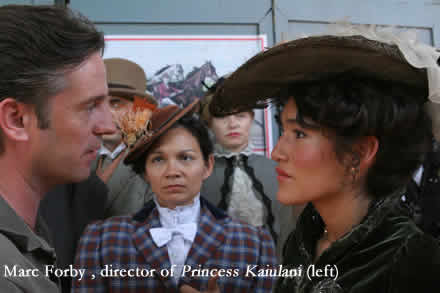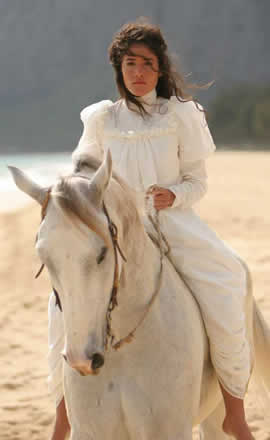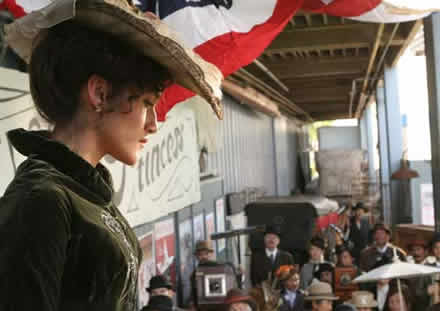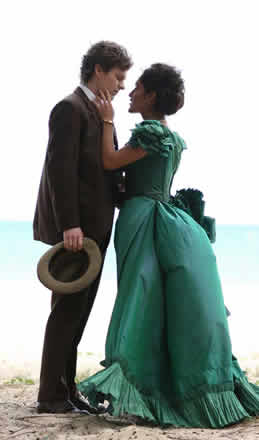 Set against the dramatic island backdrop of Hawaii and based on the inspiring true story, Princess Kaiulani is a romance about an unlikely heroine and her unwavering fight to defend the independence of her people. In 1888, Hawaii was a paradise teetering on the brink of civil unrest. The tide had turned against the long-incumbent royal family, under the malevolent influence of a rebel party with links to the American government. Within months, the Palace was overthrown, and the royals exiled. Among them was Princess Kaiulani. Scarcely 13 years old, she was separated from her family and her homeland and for her own safety, sent to a climate and a country that couldn’t be more different from Hawaii – Victorian England.
Set against the dramatic island backdrop of Hawaii and based on the inspiring true story, Princess Kaiulani is a romance about an unlikely heroine and her unwavering fight to defend the independence of her people. In 1888, Hawaii was a paradise teetering on the brink of civil unrest. The tide had turned against the long-incumbent royal family, under the malevolent influence of a rebel party with links to the American government. Within months, the Palace was overthrown, and the royals exiled. Among them was Princess Kaiulani. Scarcely 13 years old, she was separated from her family and her homeland and for her own safety, sent to a climate and a country that couldn’t be more different from Hawaii – Victorian England.
Coming to terms with her fate, Kaiulani underwent a harsh and testing education that equipped her with a sense of honor, duty and pride. What’s more, she fell in love, with the spirited and rebellious young Englishman, Clive Davies. Emerging from her childhood, and inspired by her blossoming romance, Kaiulani realized she had to bring an end to the injustices suffered by her people and set to sail for America, to meet President Grover Cleveland, to prove that she and her people were not the “barbarians” portrayed by the American press.
Marc Forby , director of Princess Kaiulani, was born in England and is based in Los Angeles. Marc fell in love with films at the age of sixteen after seeing Jean-Jacques Beineix’s Betty Blue at a  local art house theatre in Bristol. Inspired to direct, he purchased his first 16mm camera and started making documentary films at boarding school. During this time, Marc studied acting and earned a Gold Medal at the acclaimed London Academy of Music and Dramatic Arts. Marc subsequently moved to Toronto, Canada where he earned a B.A. in Film Studies at Queen’s University and was promptly hired by the prestigious Alliance Communications whose credits include Naked Lunch, Crash, Exotica and The Sweet Hereafter. Marc was eventually assigned to produce and sell features for television such as Second Skin, starring Peter Fonda and Natasha Henstridge and Joan of Arc, starring LeeLee Sobieski, which he sold to Artisan Entertainment. Marc left Alliance in 2002 to write a period epic about Hawaii’s fallen monarchy, that he financed by producing Prom Night, for Screen Gems. In 2005 his dream came true when ex-collaborator and producer, Nigel Thomas (The Wind That Shakes the Barley), agreed to take on Marc’s directing debut, Princess Kaiulani, the true story of Hawaii’s last Princess.
local art house theatre in Bristol. Inspired to direct, he purchased his first 16mm camera and started making documentary films at boarding school. During this time, Marc studied acting and earned a Gold Medal at the acclaimed London Academy of Music and Dramatic Arts. Marc subsequently moved to Toronto, Canada where he earned a B.A. in Film Studies at Queen’s University and was promptly hired by the prestigious Alliance Communications whose credits include Naked Lunch, Crash, Exotica and The Sweet Hereafter. Marc was eventually assigned to produce and sell features for television such as Second Skin, starring Peter Fonda and Natasha Henstridge and Joan of Arc, starring LeeLee Sobieski, which he sold to Artisan Entertainment. Marc left Alliance in 2002 to write a period epic about Hawaii’s fallen monarchy, that he financed by producing Prom Night, for Screen Gems. In 2005 his dream came true when ex-collaborator and producer, Nigel Thomas (The Wind That Shakes the Barley), agreed to take on Marc’s directing debut, Princess Kaiulani, the true story of Hawaii’s last Princess.
Bijan Tehrani: What motivated you to make Princess Kaiulani?
Marc Forby: It was the convergence of several things that speak about me as a person. My wife, Leilani is from Hawaii; I have always loved the Victorian era (being a fan of artists such as Tissot and Sargent); I love films about strong women and I thought this was the great untold watershed in American history.
BT: How close to the real history is your film?
MF: With the exception of the romance it is extremely accurate. There is some time compression in the opening for pacing, but nothing that changes the emotional truth. Act three is practically a blow by blow of events. The Queen was under house arrest, she did host a funeral for the nation, the Princess did host a banquet for the U.S. Senators and a Hawaiian Trio did serenade Ka`iulani with the exact song we used. Hell, we even used detail like the blue tinted sunglasses she was wearing upon her return to Oahu.
BT: Tell us about your research stage and pre-production stage. MF: The research was in many ways the most fun. There are literally thousands of her letters in the state archives all of which you can hold in your hand. The University of Hawaii was very helpful, particularly the Biography department. But you also have to listen to the elders because Hawaiians have a different way of looking at the world. Pre-production was for the most part a delight. My heads of department were rock stars. I scouted all the locations with our DP, Gabriel Beristain (SWAT, STREET KINGS, CARAVAGGIO) – he is a master at operating several cameras at once and knows how to capture natural light like nobody I know. I mean look at the film. Kathryn Morrison (EL SALVADOR, PLATOON) prepared the sensational costumes and Steven Lawrence (BATMAN RETURNS, QUANTUM OF SOLACE) magically produced sets seemingly from thin air. I think he borrowed a lot from museums. We had several blessings during pre-production which is essential when shooting in Hawaii.
MF: The research was in many ways the most fun. There are literally thousands of her letters in the state archives all of which you can hold in your hand. The University of Hawaii was very helpful, particularly the Biography department. But you also have to listen to the elders because Hawaiians have a different way of looking at the world. Pre-production was for the most part a delight. My heads of department were rock stars. I scouted all the locations with our DP, Gabriel Beristain (SWAT, STREET KINGS, CARAVAGGIO) – he is a master at operating several cameras at once and knows how to capture natural light like nobody I know. I mean look at the film. Kathryn Morrison (EL SALVADOR, PLATOON) prepared the sensational costumes and Steven Lawrence (BATMAN RETURNS, QUANTUM OF SOLACE) magically produced sets seemingly from thin air. I think he borrowed a lot from museums. We had several blessings during pre-production which is essential when shooting in Hawaii.
BT: The casting process must have been quite a challenge. Was it?
MF: Yes and no. Only Ka`iulani was a struggle. I worked hard to find a Hawaiian actress for two years and ultimately realized I needed someone with experience as the entire film would rest on her performance. Q’Orianka was the only choice for me.
BT: How did you work with your actors? Did you spend a lot of time in the rehearsal stage?
MF: I don’t like to over rehearse with actors as the dialogue becomes stale and there is less for them to discover on the day. But I did rehearse a lot with the local actors who were in many cases acting for the first time. I was blessed to find the twins who were just naturally talented. At the script stage my producer said, “You are never going to find identical twins who must be Hawaiian, act  and speak fluently in Hawaiian!” But I did!
and speak fluently in Hawaiian!” But I did!
BT: There are several mood scenes in the film, like romantic parts, where only music accompanies the actors. Did you create those scenes when editing the film or did you have them in the screenplay?
MF: I always anticipate this question, but nobody ever asks, so thank you. The answer is neither. I don’t put those scenes in the script because they don’t read well. But I knew I wanted them and my DP, 1st AD and locations department knew about them. Typically we’d deliberately wrap early and use the last half hour of the day to shoot these scenes with a very small crew and no sound. I was inspired by (Terrence) Malick who I think is a master at using the moving image and moving away from the shackles of the script. The script is just a starting point for me, not the bible.
BT: Princess Kaiulani has a classic visual style that fits the subject and era of the film. How did you come up with this visual style?
MF: Gabriel and I quickly decided on warm tones for Hawaii and cooler tones for the UK, a contrast we felt would lend an epic quality. Also, we both believe in keeping the camera moving at all times which is not classic at all. Gabriel uses a steadicam as the A camera and I will almost never do it any other way. I just don’t believe in using sticks (tripods) as the human eye is never fixed in real life. They are great for the B camera, however, for getting those 300mm beauty shots.
BT: There are many people that are not familiar with Hawaii’s history and the story of Princess Kaiulani. How has the reaction of this group been and also Hawaiians to your film?
MF: People actually love to be surprised, so the reaction has been positive. As for Hawaii, we had some protesting during the shoot, but we tied with “Precious” for the audience award at HIFF, so I guess they like it.
BT: The music accompanying the film was in most cases a solo piano. Please tell us about your choice of composer and music for Princess Kaiulani.
MF: The music is key. I am a huge fan of Stephen Warbeck. He was my first choice and he immediately said yes without any guarantee it would get made. He stuck with me for over a year. We agreed that the film was about loss, but with a sense of hope. So most of the score reflects that. I am most proud of the engagement scene because it was my boldest blocking and was the hardest musical piece for Stephen to write.
BT: Any upcoming projects?
MF: Yes, I wrote a companion to this film about a young girl in Cuba, circa 1890s who was used by Randolph Hearst to get America into the Spanish American war. It explores similar themes that I love: politics and women’s identity. But it’s much more fun and adventurous than PK and ironically has more to say. Not because PK does not have some depth, I’m just getting better at writing and expressing myself – well, we’ll see!

